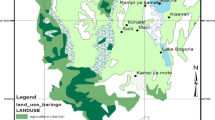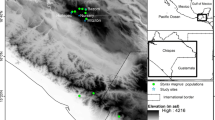Abstract
Stenocereus quevedonis (Ortega) Buxb., “pitire”, is an edible-fruit producing cactus endemic to tropical dry forests of central Mexico. It is silviculturally managed in areas disturbed for six decades. Previous studies showed that pollen flow among conserved and disturbed populations is feasible, but flower visitors have differential activity in those areas. That information and the increasing habitat fragmentation suggest possible differences in genetic diversity and gene flow among conserved and disturbed pitire populations; we therefore compared population genetics among conserved and disturbed sites, to identify actions for their in situ conservation. We sampled tissue from 20 adult pitires per site in three conserved and three disturbed sites. Samples were genotyped through six nuclear microsatellites to compare population genetics parameters through standard statistics and Bayesian analysis. Expected hetozygosity He varied (0.437–0.526), but no significant differences among disturbed and undisturbed sites were identified; gene flow Nm was 0.163–2.067, indicating overall genetic flow and drift equilibrium, but some populations show effects of drift. Genetic structure parameter Fst (0.048–0.020), indicate low genetic differentiation among populations. Bayesian analysis identified that one genetic group is absent in disturbed sites. Effects of disturbance on pitire populations are notorious due to loss of adult plants and one genetic group. Our findings suggest that low genetic differentiation might be in progress, only noticeable in genetic groups distribution but not in genetic diversity. It could be clearer in plants recruited after the disturbance events. Such effect could be buffered by actions favouring pollen and seed flow among populations.





Similar content being viewed by others
References
Arita HT (1993) Conservation biology of the cave bats of Mexico. J Mamm 74:693–702
Arréola-Nava H (2006) Sistemática Filogenética del Género Stenocereus (Cactaceae). Dissertation, Instituto de Enseñanza e Investigación en Ciencias Agrícolas, Mexico
Arreola-Nava H, Terrazas T (2003) Especies de Stenocereus con areolas morenas: clave y descripciones. Act Bot Mex 64:1–18
Bárcenas RT, Yesson C, Hawkins JA (2011) Molecular systematics of the Cactaceae. Clad 27:470–489
Barnosky AD, Hadly EA, Bascompte J et al (2012) Approaching a state shift in Earth’s biosphere. Nature 486:52–58
Barthlott W, Hunt DR (1993) Cactaceae. In: Kubitzki K (ed) The families and genera of vascular plants. Springer, New York, pp 161–197
Bawa KS (1990) Plant pollinator interactions in tropical rain forests. Annu Rev Ecol Syst 21:399–422
Beerli P, Felsenstein J (2001) Maximum likelihood estimation of a migration matrix and effective population sizes in n subpopulations by using a coalescent approach. Proc Natl Acad Sci 98:4563–4568
Buchmann SL, Nabhan GP (1996) The forgotten pollinators. Island Press, Covelo
Casas A, Barbera G (2002) Mesoamerican domestication and diffusion. In: Nobel P (ed) Cacti: biology and uses. University of California Press, Los Angeles, pp 143–162
Casas A, Caballero J, Valiente-Banuet A (1999) Use, management and domestication of columnar cacti south-central Mexico: a historical perspective. J Ethnob 19:71–95
Casas A, Lira R, Torres I et al (2016) Ethnobotany for sustainable ecosystem management: a regional perspective in the Tehuacán Valley. In: Lira R, Casas A, Blancas JJ (eds) Ethnobotany of Mexico. Interaction of people and plants in Mesoamerica. Springer, New York, pp 179–206
Chapuis MP, Estoup A (2007) Microsatellite null alleles and estimation of population differentiation. Mol Biol Evol 24:621–631
Chybicki IJ, Burczyk J (2009) Simultaneous estimation of null alleles and inbreeding coefficients. J Hered 100:106–113
Cole FR, Wilson E (2006) Leptonycteris yerbabuenae. Mamm Sp 797:1–7
Comisión Nacional de Áreas Naturales Protegidas (2012) Programa de Manejo Formulado de la Reserva de la Biosfera Zicuirán-Infiernillo. CONANP, Mexico
Cruse Sanders J, Parker C, Friar E, Huang D, Mashayekhi S, Prince L, Otero Arnaiz A, Casas A (2013) Managing diversity: domestication and gene flow in Stenocereus stellatus Riccob. (Cactaceae) in Mexico. Ecol Evol 3:1340–1355
Díaz-Cardenas B, Gómez-Flores L. Rosas-Espinoza VC et al. (2009). Obtención de ADN de cactáceas: comparación de dos métodos de extracción en Ferocactus histrix. En: Carvajal S, Pimienta- Barrios E (ed) Avances en la investigación científica en el CUCBA, Universidad de Guadalajara, Guadalajara, Jalisco, Mexico, pp 123–129
Doyle J, Doyle JL (1987) Genomic plant DNA preparation from fresh tissue-CTAB method. Phytochem Bull 19:11–15
Earl DA, von Holdt BM (2012) Structure Harvester: a website and program to visualizing structure output and implementing the Evanno method. Conserv Gen Resour 4:359–361
Evanno G, Regnaut S, Goudet J (2005) Detecting the number of clusters of individuals using the software STRUCTURE: a simulation study. Mol Ecol 14:2611–2620
Felger RS, Moser MB (1985) People of the desert and sea. Ethnobotany of the Seri Indians. The University of Arizona Press, Tucson
Forman RTT (1995) Land mosaics: the ecology of landscapes and regions. Cambridge University Press, Cambridge
Godínez-Alvarez H, Ríos-Casanova L, Pérez F (2005) Characteristics of seedling establishment of Stenocereus stellatus (Cactaceae) in the Tehuacán Valley. Mex Southwest Nat 50:375–380
Golubov J, Martínez Valenzuela PA, Durán Campos EJ, Martínez-Cervantes Y (2010) Distribición espacial y nodricismo en Mammillaria carnea en el Municipio de Valerio Trujano, Cuicatlán. Oaxaca Cact Suculent Mex 55:56–64
Guillot G, Mortier F, Estoup A (2005) A computer package for landscape genetics. Mol Ecol Not 5:708–711
Hunt D (1992) CITES Cactaceae checklist. Royal Botanic Gardens, Kew
Jacquemyn H, Brys R, Hermy M (2002) Patch occupancy, population size and reproductive success of a forest herb Primula elatior in a fragmented landscape. Oecologia 130:617–625
Jules ES, Rathcke BJ (1999) Mechanisms of reduced Trillium recruitment along edges of old-growth forest fragments. Conserv Biol 13:784–793
Klapwijk MJ, Lewis OT (2008) Effects of climate change and habitat fragmentation on trophic interactions. In: Claro KD, Oliveira PS, Rico-Gray V (eds) Tropical biology and conservation management. Encyclopedia of life support systems. UNESCO, Oxford
Lozano-Garza OA (2013) Análisis de la estructura genética poblacional de la pitaya agria (Stenocereus gummosus) en el desierto sonorense. Dissertation. Centro de Investigaciones Biológicas del Noroeste, Baja California Sur, México
Lozano-Garza OA, León de la Luz JL, Favela Lara S, García de León F (2015) New interpretations about clonal architecture for the sour pitaya (Stenocereus gummosus, Cactaceae), arising from microsatellite markers of de novo isolation and characterization. Open J Gen 5:1–11
McNeely JA, Miller KR, Reid WV, Mittermeier RA, Werner TB (1990) Conserving the world’s biological diversity. World Conservation Union, World Resources Institute, Conservation International, World Wildlife Fund–US, and the World Bank, Washington
Méndez M, Dorantes A, Dzib G, Argáez J, Durán R (2006) Germination and seedling establishment of Pterocereus gaumeri a columnar, rare and endemic cactus from Yucatan. Mex Bot Sci 79:33–41
Millenium Ecosystem Assessment (2005) Ecosystems an human well-being. biodiversity synthesis. World Resources Institute, Washington
Murcia C (1995) Edge effects in fragmented forests: implications for conservation. Trends Ecol Evol 10:58–62
Nabuurs GJ, Masera O, Andrasko K et al (2007) Forestry. Climate Change (2007): Mitigation. Contribution of working group III to the fourth assessment report of the intergovernmental panel on climate change. Cambridge University Press, Cambridge
Otero- Arnaiz A, Cruse-Sanders J, Casas A, Hamrick JL (2004) Isolation and characterization of microsatellites in the columnar cactus: Polaskia chichipe and cross-species amplification within the Tribe Pachycereeae (Cactaceae). Mol Ecol Notes 4:265–267
Parra F, Casas A, Rocha V, González-Rodríguez A, Arias-Montes S, Rodríguez-Correa H, Tovar J (2014) Spatial distribution of genetic variation of Stenocereus pruinosus (Otto) Buxb. in Mexico: analysing evidence on the origins of its domestication. Genet Resour Crop Evol 62:893–912
Peakall R, Smouse PE (2006) GENALEX 6: genetic analysis in Excel. Population genetic software for teaching and research. Mol Ecol Not 6:288–295
Piñero D, Caballero-Mellado J, Cabrera-Toledo D, Canteros CE, Casas A et al (2008) La diversidad genética como instrumento para la conservación y el aprovechamiento de la biodiversidad: estudios en especies mexicanas. In: Sarukhán J (ed) El Capital natural de México, vol 1. Conocimiento actual de la biodiversidad. CONABIO, México, pp 437–494
Pritchard JK, Stephens M, Donnelly P (2000) Inference of population structure using multilocus genotype data. Genetics 155:945–959
Rangel-Landa S, Dávila P, Casas A (2015) Facilitation of Agave potatorum: an ecological approach for assisted population recovery. For Ecol Manag 347:57–74
Rodríguez-Oseguera AG, Casas A, Herrerías-Diego Y, Pérez-Negrón E (2013) Effect of habitat disturbance on pollination biology of the columnar cactus Stenocereus quevedonis at landscape-level in central Mexico. Plant Biol 15:573–582
Saunders DA, Richard JH, Chris RM (1991) Biological consequences of ecosystem fragmentation: a review. Conserv Biol 5:18–32
Suzán H, Nabhan GP, Patten DT (1994) Nurse plant and floral biology of a rare night- blooming cereus, Peniocereus striatus (Brandegee) F. Buxbaum. Conserv Biol 8:461–470
Van Oosterhout C, Hutchinson WF, Wills DPM, Shipley P (2004) MICROCHECKER: software for identifying and correcting genotyping errors in microsatellite data. Mol Ecol Not 4:535–538
Vitousek PM (1994) Beyond global warming: ecology and global change. Ecology 75:1861–1876
Yetman D (1998) Scattered round stones. University of Arizona Press, Tucson
Yetman D, Van Devender TR (2002) Mayo ethnobotany: land, history and traditional knowledge in northwestern Mexico. University of California Press, Berkeley
Acknowledgements
The authors thank financial support from the Research Projects CONACYT CB-2013-01-221800 and PAPIIT, DGAPA, UNAM IN206217. We also thank Edgar Pérez-Negrón for fieldwork assistance and Carmen Julia Figueredo for help in laboratory work.
Author information
Authors and Affiliations
Corresponding author
Ethics declarations
Conflict of interest
The authors declare that they do not have conflict of interest with any person.
Rights and permissions
About this article
Cite this article
Paz-Guerrero, F., Casas, A. & Alvarado-Sizzo, H. Habitat fragmentation and population genetics of Stenocereus quevedonis (Cactaceae) in Michoacán, México: bases for in situ conservation of silvicultural managed genetic resources. Genet Resour Crop Evol 66, 633–643 (2019). https://doi.org/10.1007/s10722-018-00737-7
Received:
Accepted:
Published:
Issue Date:
DOI: https://doi.org/10.1007/s10722-018-00737-7




